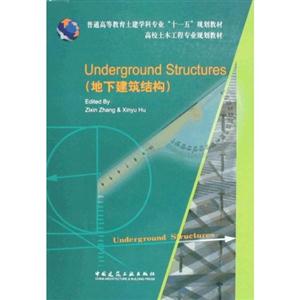PrefaceSymbols1 Introduction 1.1 Underground Elements 1.2 Details Problems Reference and Bibliography2 Design Load 2.1 Types of Loading 2.2 Lateral Earth Pressure 2.2.1 Earth Pressure at Rest 2.2.2 Rankine' s Earth Pressure Theory 2.2.3 Coulomb' s Earth Pressure Theory 2.3 Rock Mass Pressure 2.3.1 Loosening Masses Theory 2.3.2 Rational methods 2.4 The "Q" System 2.5 Pressures of Ground-Structure Interaction 2.6 Deadweight of Structure and other loads .. Problems Reference and Bibliography3 Design Methods 3.1 Load Structure Model 3.2 Convergence-confinement Method 3.2.1 Introduction 3.2.2 Presentation of the method 3.2.3 Theoretical Scope of the Method 3.2.4 Practical scope of the method 3.3 Rational Methods of design 3.3.1 The state of stress and the plastic zone around a tunnel 3.3.2 Stresses in the plastic zone 3.3.3 Stresses in the elastic zone 3.3.4 Radius of the plastic zone 3.3.5 Displacement around the tunnel 3.3.6 Displacement of the lining 3.3.7 Compatibility condition of the displacements between the ground and the lining 3.3.8 Calculation of the values of Rp and Pi 3.3.9 Calculation of segmental linings of shield tunnels 3.3.10 Case studies 3.4 Empirical Design Method-The Q-System 3.5 NATM Method 3.5.1 Introduction 3.5.2 Historical background of NATM 3.5.3 Characteristics features and philosophy of NATM 3.6 Discontinuity Analysis Method 3.6.1 Introduction 3.6.2 Joint Spacing: Joint Spacing, Frequency, Block Size, and RQD 3.6.3 Joint Surface and Opening: Roughness, Matching, Aperture and FiUing 3.6.4 Mechanical and Hydraulic Properties of Rock Joints, Fractures and fault zones 3.6.5 Field and Laboratory Characterization of Rock Joints 3.6.6 Stability Analysis of Joint Rock mass 3.6.7 Numerical Methods Problems Reference and Bibliography4 Numerical Methods 4.1 Introduction 4.2 Finite Element Method (FEM) 4.2.1 History 4.2.2 Strengths and weaknesses 4.3 Finite Difference Method (FDM) 4.4 Boundary Element Method (BEM) 4.5 Discrete Element Method (DEM) 4.5.1 Introduction 4.5.2 Outline of the method 4.6 Comparison of Numerical Methods 4.7 How Does The Finite Element Method Work? 4.7.1 Fundamental Concepts 4.7.2 Main Steps For Finite Element Method 4.8 Phased Excavation of A Shield Tunnel 4.8.1 Soil Constitutive Models 4.8.2 Soil model Parameters 4.8.3 Tunnelling Simulation Model 4.8.4 Results of Three Soil Models 4.8.5 Tunnelling Simulation Method 4.8.6 Case study of a shield tunnel Problems Reference and Bibliography5 Underground Structures in Soil 5.1 Design of Diaphragm wall 5.1.1 Methods of Design 5.1.2 Method of Construction 5.2 Retaining Wall 5.2.1 Retaining Wall Selection 5.2.2 Retaining Wall Layouts 5.2.3 Plans for Specific Wall Types 5.3 Immersed Tube Tunnel 5.3.1 History 5.3.2 Design and construction of immersed tube tunnel Problems Reference and Bibliography6 Underground Structures in Rock 6.1 Design of Indeterminate Structures 6.1.1 Analysis of Statically Indeterminate Structures by the Matrix Force Method 6.1.2 Simple Example 6.2 Shaft 6.2.1 Purpose of a Shaft 6.2.2 Shaft Cross Sections 6.2.3 Determining Shaft Size 6.2.4 Choosing the Right Shaft 6.2.5 Criteria for choosing a Vertical Shaft 6.2.6 Criteria for choosing a Decline or Inclined Shaft ... 6.2.7 Design Process Summary 6.3 Cavern 6.3.1 Cavern Design and Cavern Construction 6.3.2 Design of large underground caverns Problems Reference and Bibliography7 Rock Reinforcement 7.1 Rock Support Philosophy 7.2 Design Approaches 7.2.1 Empirical Approaches 7.2.2 Analytical Approaches 7.2.3 Numerical Approaches 7.3 Rock bolt 7.3.1 Types of rock bolts 7.3.2 Rock reinforcement installation 7.4 Shotcrete 7.4.1 Introduction 7.4.2 Shotcrete technology 7.5 Design of shotcrete support Problems Reference and Bibliography8 Tunnelling in Rock 8.1 Introduction 8.2 Primary concerns 8.3 General Procedure in Designing a Tunnel 8.4 Site Characterization 8.5 Rock Mass Characterization 8.6 Tunnel Geometry 8.7 Different Approaches Based on Ground Conditions and Tunnelling Methods 8.8 Structural Design Models for Tunnelling 8.8.1 Continuum or Discontinuum Model 8.8.2 Empirical Approach 8.8.3 Observational Method 8.8.4 Special Design Features 8.9 In-Situ Monitoring 8.9.1 Purpose of In-Situ Measurements 8.9.2 Monitoring Methods 8.9.3 Interpreting Results of In-Situ Monitoring 8.10 Design of a Tunnel by Empirical Methods 8.11 The Future of Rock Tunnelling Problems Reference and Bibliography9 Soft Ground Tunneling 9.1 Types of Ground 9.1.1 Residual Soils 9.1.2 Silty Clays 9.1.3 Cohesive Soils 9.1.4 Silty Sands Above/Below the Water Table 9.1.5 Transported Soils 9.2 Soft Ground Tunnelling Methods 9.2.1 History 9.2.2 Geotechnology 9.2.3 EPB Shield 9.2.4 Slurry Shield 9.2.5 Mixshield 9.3 Selection of Soft Ground Tunnelling Machine 9.3.1 Simple Shields 9.3.2 Multiple-heading Shields 9.4 Stability of the Tunnel Face 9.5 Lining Design 9.5.1 Force-method Equations 9.5.2 Design of Shield Tunnel Lining 9.5.3 Schematic Example of Step-by-Step Design Procedure Problems Reference and Bibliography

















